Sensors Directorate
-
- Dr. Jennifer Brower, Prometheus Marine Technology, Nov 2013 #18
Prometheus Inc., incorporated in 1983, is a mathematics and engineering research firm that specializes in the application of high-level mathematics to modeling, simulation and signal processing. Last month MTR caught up with Dr. Jennifer Brower to discuss the company's position in the marketplace and outlook for 2014 and beyond.
Please discuss your background, how you came to your current field, including details on your tenure and role @ Prometheus.
I have been a Prometheus Principal Scientist and Administrator for 18 years. While at Prometheus I have developed technology applications for Prometheus algorithms, co-developed a DCAA approved accounting system and managed several Prometheus efforts in mathematics and business development, including current efforts to integrate the Materials Identification Reflectivity Kernel algorithm suite into the ANN/BQQ-10 sonar system.
In addition, as Executive Vice President of the International Neuroscience Network Foundation (INNF), I managed a large four-year multinational neuroscience project for Nestle examining the relationships among taste psychophysics, metabonomics and genetics. I also led INNF’s education outreach program, working to stimulate STEM (science, technology, engineering and math) interest and excellence in K-12 students.
While at RAND, I was Co-Director of the Congressionally-mandated Advisory Panel to Assess Domestic Response to Terrorism Involving Weapons of Mass Destruction (the Gilmore Commission). As part of this well-regarded multi-year project, I supervised more than 50 personnel and developed and oversaw the research agenda for the panel, which included research on technologies to combat (biological, chemical, infrastructure) terrorism as well as policies and procedures in the areas of critical infrastructure, border protection, and health and emergency services.
I completed a National Research Council postdoctoral fellowship at the Naval Research Laboratory in Washington, D.C., and I hold a Ph.D. in Environmental Engineering and Microbiology from Harvard University, and two Bachelor degrees in Engineering from Dartmouth College and the Thayer School of Engineering at Dartmouth College. I have co-authored several peer-reviewed articles, fsbook chapters and books.
Looking at Prometheus’ turnover in a given year, please give an overview description of your client base.
Prometheus’ client base is primarily the Department of Defense and defense contractors. Currently, our primary customer is the U.S. Navy and more specifically the Naval Sea Systems Command and the Office of Naval Research. Our projects are moving from more basic research support from DoD to transition and integration support from DoD and the commercial sectors. In addition to the aforementioned the following organizations have been our clients: Space and Naval Warfare Systems Command, San Diego; Defense Advanced Research Projects Agency; the U.S. Air Force including Brooks AFB / Citybase, U.S. Air Force Office of Scientific Research, Mathematics and Information Sciences and the U.S. Air Force Research Laboratory, Sensors Directorate, Rome, New York; the U.S. Army including the Space and Missile Defense Technical Center, Huntsville and the DASD Munitions and Chemical Matters, OUSD AT&L. We have partnered with Raytheon, BBN Inc., Cisco Systems and Newport News Shipbuilding to bring technology solutions to the DoD.
Looking at the military / defense applications: what are the overriding drivers for your business in this market today?
The overriding drivers for our technology are the ability to do intensive computation onboard defense systems due to leaps in computing power and the need for technology solutions that will significantly increase performance of existing systems while reducing costs.
Specifically, can you share with MTR readers a specific, recent project where your specialized applications were applied to significantly enhance production, reduce costs, or both?
Prometheus is currently working to integrate its algorithm suite MIRK into the AN/BQQ-10 sonar. It is anticipated to significantly reduce false alarms and work in real time based on results with at sea data, saving the Navy both time and money. This algorithm suite was first developed for radar, and there have been and will be future cost efficiencies because the algorithm has been and can be adapted to multiple active sonar and radar systems.
In analyzing the subsea market, what do you count as the biggest technological leaps that have most affected our ability to collect, disseminate and analyze data from the oceans?
Similar to the third question, increases in computing power allow MIRK and other Prometheus algorithms to work in real time, in a single pass on board a variety of Navy and other defense systems. The creation of numerous platforms including UUVs and AUVs that will benefit significantly from the integration of Prometheus algorithms also allows increased data collection and analysis of results.
The premise of your firm sounds fairly straightforward: to use software solutions in lieu of more timely and costly hardware switches. Give perspective, if you will, on how prevalent this concept is today in the subsea industry.
The concept is prevalent due to technology advances and budget constraints, but the integration of truly autonomous, real-time, single pass software is rare.
What do you consider the greatest challenges to making it more commonplace?
One great challenge is connecting small business technology/software developers with DoD and prime contractors. It is difficult, particularly for businesses new to defense contracting, to understand the specific needs and systems. The contracting process itself also stands in the way to innovative software integration.
What initiatives specifically do you as a company engage to help spread your solutions?
We present at conferences, actively review government opportunities on FedBizOpps, actively seek out opportunities on the web and contact the relevant people, arrange meetings, and develop partnerships and hire people with experience with various market segments.
Military spending has increasingly come under tight constraints. How has this impacted your business (ie. have you seen an uptick in attracting business by showing how various tasks can be accomplished more cost effectively?
This allows us to sell our message more effectively - to improve our customers’ system performance by the formulation, design and integration of accurate and computationally efficient algorithms.
What do you consider the biggest challenge to running your business, efficiently and effectively, today?
The tremendous burden of contracting and other regulations on small businesses. Each person who works for Prometheus must be able to do a little bit of everything, as opposed to larger companies who have departments to deal with contracting, security, etc.
21 Arnold Ave., Newport, R.I., U.S. 02840
Tel: 1-401-849-5389
Email [email protected]
Website: www.prometheus-us.com
CEO/President: Jim Byrnes
Number of Employees: 26Prometheus Inc., incorporated in 1983, is a mathematics and engineering research firm that specializes in the application of high-level mathematics to modeling, simulation and signal processing. Its objective is to improve its customers’ system performance by the formulation, design and integration of accurate and computationally efficient algorithms. Developers of radar, sonar and oceanographic systems which require management and analysis of large amounts of data are our principal customers. In most cases it eliminates the need for changes in hardware. Its goal: Provide mathematical solutions and real-time code to improve system performance at reduced costs.
Prometheus has provided computationally efficient mathematical solutions for: remote material discrimination with radar and sonar; feature-based pattern recognition; real time broadband reverberation modeling; closely spaced object discrimination; waveform diversity, particularly for space-based radar and the Advanced Acquisition Decision Aid to evaluate technology investments. Supported by the U.S. Navy, Air Force and National Reconnaissance Office ,Prometheus developed algorithms leading to the automatic determination and discrimination, in intense clutter, of organic materials including foliage, people, chemicals and biologicals at various temperatures and moisture content, as well as man-made objects such as submarines and mines. Its algorithms compute materials identification in real time from scattered measurements, have good noise rejection and are robust to clutter. Its success in providing the Fleet with information not available in today’s operational sonar systems is exemplified by the FY12 award of a $3 million Rapid Innovation Fund contract by the Navy, which funded only 34 of the several thousand proposals received.
(As published in the November/December 2013 edition of Marine Technology Reporter - www.seadiscovery.com)
-
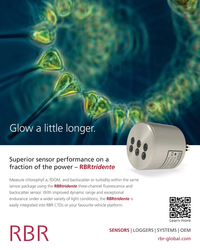 )
March 2024 - Marine Technology Reporter page: 4th Cover
)
March 2024 - Marine Technology Reporter page: 4th Coverof light conditions, the RBRtridente is easily integrated into RBR CTDs or your favourite vehicle platform.ur favourite vehicle platform. Learn more SENSORS | LOGGERS | SYSTEMS | OEM rbr-global.com MTR MarApr2023 Covers 2,3 and 4.indd 3 3/7/2023 12:39:50 P
-
 )
March 2024 - Marine Technology Reporter page: 45
)
March 2024 - Marine Technology Reporter page: 45zero carbon emissions • Teledyne Marine Acquires Valeport Teledyne Marine agreed to acquire Valeport a leader in the design and manufacture of underwater sensors and pro? l- ers. Valeport is one of the UK’s leading manufacturers of oceanographic and hydrographic instrumentation. The in- dependent family-owned
-
 )
March 2024 - Marine Technology Reporter page: 44
)
March 2024 - Marine Technology Reporter page: 44NEW TECH OCEANOLOGY INTERNATIONAL 2024 Image courtesy Metron/Cellula Teledyne Marine acquires Valeport: Matt Quartley, MD, Valeport and Ole Søe-Pedersen, VP & Image courtesy Teledyne Marine GM Teledyne Marine announce the deal in London. Pictured (L-R): Cellula Robotics, President, Eric Jackson, Metron
-
 )
March 2024 - Marine Technology Reporter page: 41
)
March 2024 - Marine Technology Reporter page: 41in col- laboration with Hereon for the Helmholtz Association’s MO- SES initiative, focuses on monitoring ocean eddies. These ve- hicles are equipped with sensors for collecting geo-referenced data on various physical water parameters, including tempera- ture, pressure, oxygen, conductivity, and ? uorescence
-
 )
March 2024 - Marine Technology Reporter page: 30
)
March 2024 - Marine Technology Reporter page: 30a routing system that keeps the Digital twin technology analyzes data gathered from mul- umbilical in a single plane during collector operations. tiple sensors and assets to enable 3D visualization of op- The collector’s front-mounted Coandã-effect nozzles guide erations in real time. AI modelling can then
-
 )
March 2024 - Marine Technology Reporter page: 26
)
March 2024 - Marine Technology Reporter page: 26FEATURE OCEANOGRAPHIC INSTRUMENTATION & SENSORS Kevin Mackay, TESMaP voyage leader and Center head of the South and West Paci? c Regional Centre of Seabed 2030. Kevin in the seismic lab at Greta Point looking at the Hunga Tonga-Hunga Ha’apai volcano 3D map completed with data from the TESMaP voyage
-
 )
March 2024 - Marine Technology Reporter page: 25
)
March 2024 - Marine Technology Reporter page: 25mapped the shape of the Wavelet 2KW at 250ms Ping Rate CorrelaO on > 0.96 caldera and measured the environmental conditions of water above it. Sensors on board collected additional data, explained SEA-KIT Operations Director Ash Skett, including bathymetric and water column backscatter conditions
-
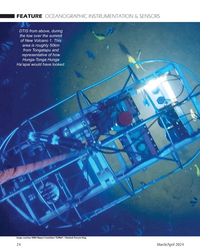 )
March 2024 - Marine Technology Reporter page: 24
)
March 2024 - Marine Technology Reporter page: 24FEATURE OCEANOGRAPHIC INSTRUMENTATION & SENSORS DTIS from above, during the tow over the summit of New Volcano 1. This area is roughly 50km from Tongatapu and representative of how Hunga-Tonga Hunga Ha’apai would have looked. Image courtesy NIWA-Nippon Foundation TESMaP / Rebekah Parsons-King 24
-
 )
March 2024 - Marine Technology Reporter page: 22
)
March 2024 - Marine Technology Reporter page: 22FEATURE OCEANOGRAPHIC INSTRUMENTATION & SENSORS Aerial view of HT-HH volcano, showing new multibeam depth data overlaid on islands satellite image. © SEA-KIT, NIWA-Nippon Foundation TESMaP 22 March/April 2024 MTR #3 (18-33).indd 22 4/4/2024 9:08:10 AM
-
 )
March 2024 - Marine Technology Reporter page: 18
)
March 2024 - Marine Technology Reporter page: 18valuable data. The the measurement of protection levels (potential) using non- increased speed saves costly vessel time, while the larger mea- contact sensors. The collected data is then merged with CP surement distance lowers the risks associated with the ? ight modeling to provide a comprehensive analysis
-
 )
March 2024 - Marine Technology Reporter page: 17
)
March 2024 - Marine Technology Reporter page: 17, either by divers or ROVs. tact surveys using ? eld gradient sensor technology. Standard The probe typically consists of one or two silver/silver chlo- sensors in this ? eld work by detecting potential differences ride (Ag/AgCL) reference electrodes. A voltmeter measures between the Ag/AgCl cells, placed
-
 )
March 2024 - Marine Technology Reporter page: 16
)
March 2024 - Marine Technology Reporter page: 16TECH FEATURE IMR Image courtesy FORCE Technology OPTIMIZING CATHODIC PROTECTION SURVEY USING NON-CONTACT SENSORS By Svenn Magen Wigen, FORCE Technology he principle behind sacri? cial anodes, which are water structures, reducing the need for frequent repairs and used to safeguard underwater pipelines
-
 )
March 2024 - Marine Technology Reporter page: 15
)
March 2024 - Marine Technology Reporter page: 15, Shea Quinn is the Product Line Manager the Sentinel can run several high-energy passive and active of the Slocum Glider at Teledyne Webb acoustic sensors, on-board processing, and imaging hardware Research. Quinn came to Teledyne Webb Research from Lockheed Martin. He simultaneously for months at
-
 )
March 2024 - Marine Technology Reporter page: 14
)
March 2024 - Marine Technology Reporter page: 14piloting, crease mission length to over 2 years; or users can ? t more ? ight control, and communications architecture of the Slocum high-energy sensors like active or passive acoustics, sensors Glider, and allows for the same sensor and hardware options with on-board processing, and imaging, without
-
 )
March 2024 - Marine Technology Reporter page: 13
)
March 2024 - Marine Technology Reporter page: 13the popular- so did demand for increased capabil- The Slocum Sentinel Glider scales ity this type of platform has seen over ity: longer missions, more sensors – the standard Slocum Glider through an the past two decades, growing from especially high-energy sensors – and increased diameter to gain better
-
 )
March 2024 - Marine Technology Reporter page: 11
)
March 2024 - Marine Technology Reporter page: 11is a defense analyst and founder of lenges. Unlike contact mines, bottom Strikepod Systems, a research and strategic advisory mines utilize a range of sensors to de- focusing on autonomous undersea systems. tect their prey – acoustic, magnetic, pressure – and as such pose a hazard to manned MCM vessels
-
 )
March 2024 - Marine Technology Reporter page: 9
)
March 2024 - Marine Technology Reporter page: 9from marinas along the western coast. The exact number of lizing laser detection systems can detect mines just below the mines, as well as their locations, remains largely a mystery, surface, even those hiding in murky water. The Airborne Laser although reports suggest that over three hundred have been
-
 )
April 2024 - Maritime Reporter and Engineering News page: 48
)
April 2024 - Maritime Reporter and Engineering News page: 48TRANSDUCERS [email protected] Silicon Sensing Systems Ltd, Clittaford Road Southway, Massa Products Corporation, 280 Lincoln Street, UNDERWATER SONAR SENSORS Plymouth, Devon PL6 6DE United Kingdom , UK , Hingham, MA 02043-1796 , tel:(781) 749-4800, tel:+44 (0) 1752 723330, [email protected] nel@massa
-
 )
April 2024 - Maritime Reporter and Engineering News page: 41
)
April 2024 - Maritime Reporter and Engineering News page: 41Nautel provides innovative, industry-leading solutions speci? cally designed for use in harsh maritime environments: • GMDSS/NAVTEX/NAVDAT coastal surveillance and transmission systems • Offshore NDB non-directional radio beacon systems for oil platform, support vessel & wind farm applications
-
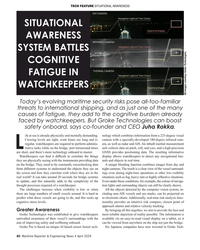 )
April 2024 - Maritime Reporter and Engineering News page: 40
)
April 2024 - Maritime Reporter and Engineering News page: 40TECH FEATURE SITUATIONAL AWARENESS SITUATIONAL AWARENESS SYSTEM BATTLES COGNITIVE FATIGUE IN WATCHKEEPERS All images courtesy Groke Technologies Today’s evolving maritime security risks pose all-too-familiar threats to international shipping, and as just one of the many causes of fatigue, they add
-
 )
April 2024 - Maritime Reporter and Engineering News page: 39
)
April 2024 - Maritime Reporter and Engineering News page: 39Tech Files Latest Products, Systems and Ship Designs “Wall Climbing Robot” Danish Pilot calls gets ClassNK Nod LEGO Model "A tribute build to a work life at sea" Image courtesy MOL, Sumitomo Heavy Industries lassNK granted its Innovation Endorse- Image courtesy Espen Andersen/DanPilot ment for
-
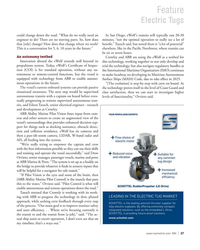 )
April 2024 - Marine News page: 37
)
April 2024 - Marine News page: 37Eileen Tausch, senior electrical engineer - research and development at Crowley. ABB Ability Marine Pilot Vision fuses input from cam- eras and other sensors to create an augmented view of the vessel’s surroundings that provides enhanced decision sup- port for things such as docking assistance, obstacle
-
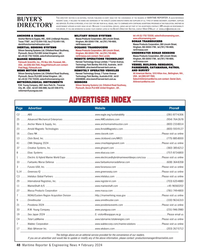 )
February 2024 - Maritime Reporter and Engineering News page: 48
)
February 2024 - Maritime Reporter and Engineering News page: 48TRANSDUCERS [email protected] Silicon Sensing Systems Ltd, Clittaford Road Southway, Massa Products Corporation, 280 Lincoln Street, UNDERWATER SONAR SENSORS Plymouth, Devon PL6 6DE United Kingdom , UK , Hingham, MA 02043-1796 , tel:(781) 749-4800, tel:+44 (0) 1752 723330, [email protected] nel@massa
-
 )
February 2024 - Maritime Reporter and Engineering News page: 44
)
February 2024 - Maritime Reporter and Engineering News page: 44Tech Files Latest Products & Technologies MarineShaft Yanmar Hydrogen MarineShaft specializes in urgent re- Fuel Cell AIP pair/replacement of damaged rudder and Yanmar Power Technology Co., Ltd. propeller equipment along with many (Yanmar PT), a subsidiary of Yanmar on-site repair services. MarineShaft
